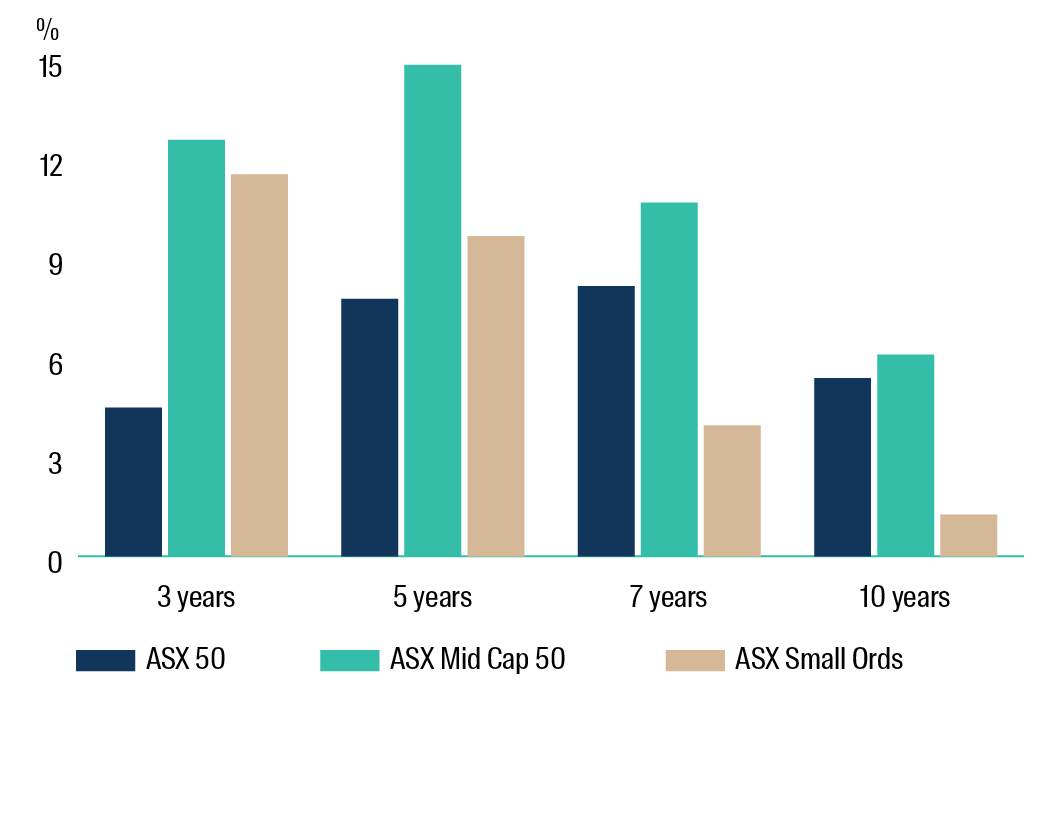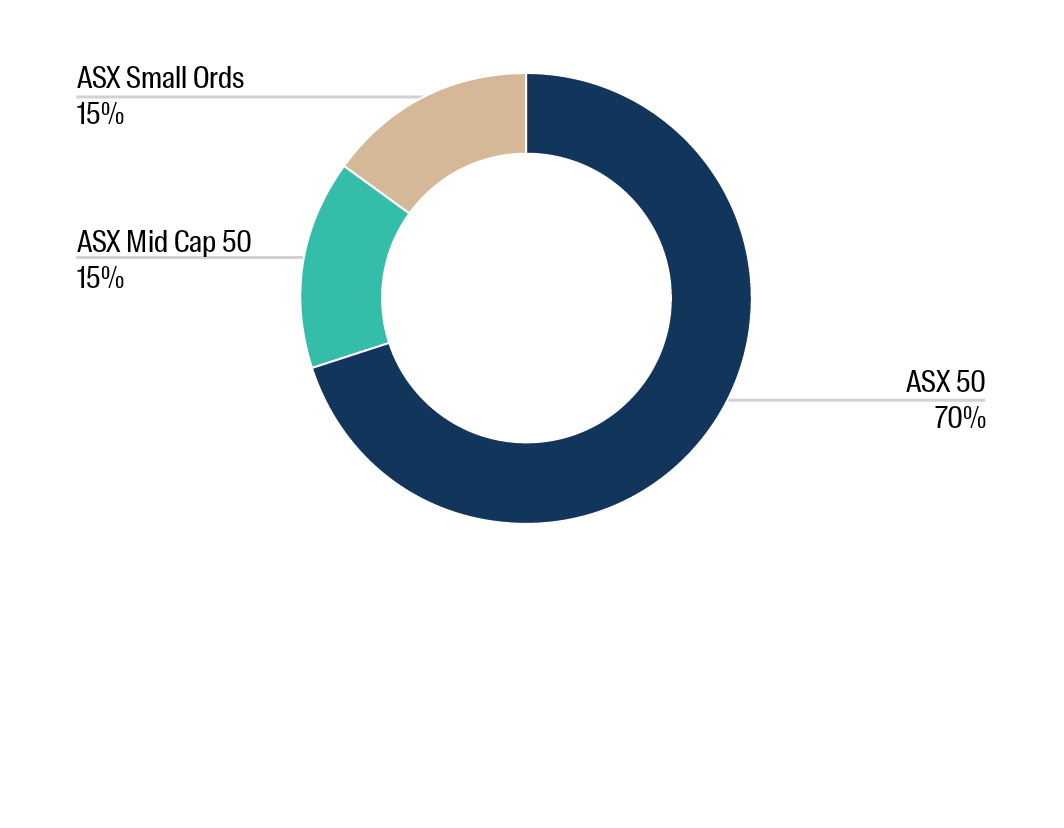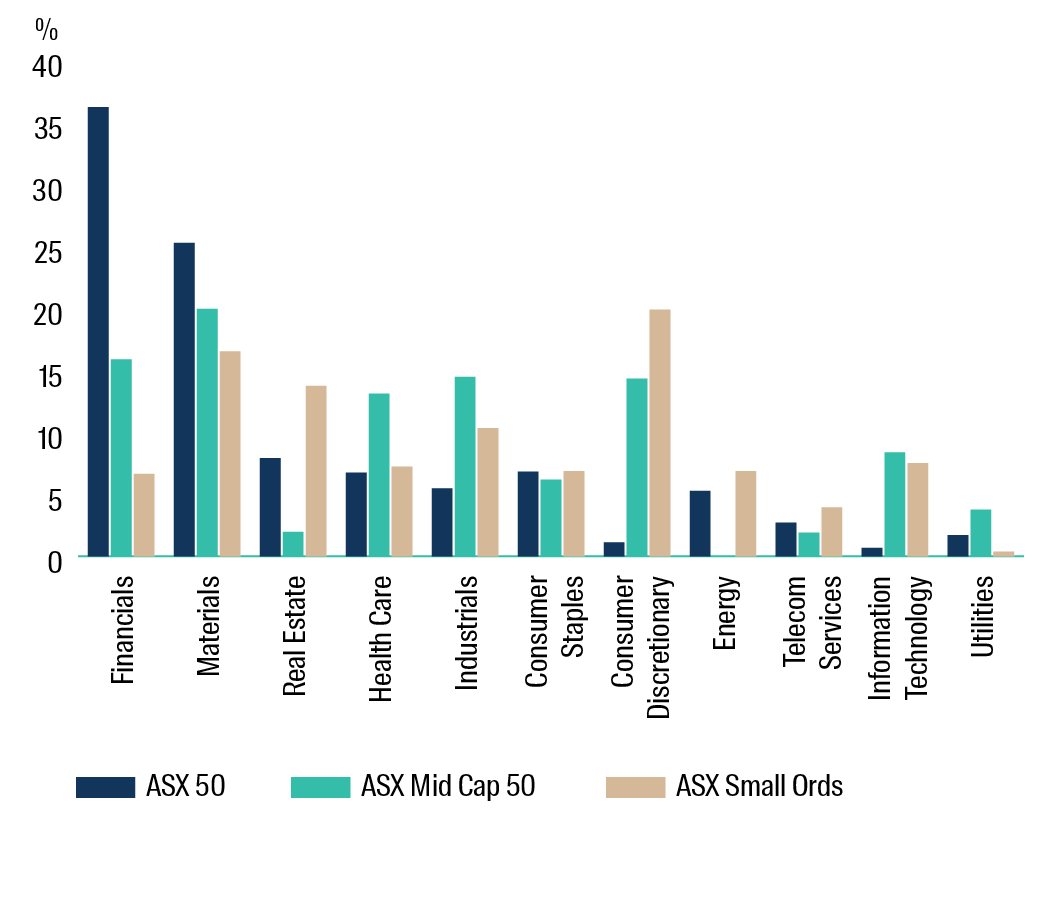The mid caps space is characterised by successful companies with strong growth profiles, which can offer attractive diversification benefits to Australian equity portfolios. Yet they comprise only a small proportion of a typical broad-based portfolio. In this article we highlight some of the attractive characteristics of this often-overlooked segment of the market.
About mid caps
‘Mid caps’ generally refers to Australia’s 51 to 100 largest companies and are represented in the S&P/ASX Mid Cap 50 Index. Companies that sit in this band have a number of attractive characteristics for investors. Not least, they have outperformed the S&P/ASX 50 Index and S&P/ASX Small Ordinaries Index over three, five, seven and ten years. Despite this consistent outperformance, mid caps usually comprise only a small proportion of broad-based portfolios which invest in the S&P/ ASX 300, and are omitted altogether in small cap portfolios which are limited to the S&P/ASX Small Ordinaries Index.
Chart 1: Annualised performance of large, mid and small cap indices

Source: Bloomberg. Data to 31 May 2018. Returns are annualised. Past performance is not an indicator of future performance.
Mid cap stocks generally trade on a higher price to earnings ratio to the broader ASX 300, to account for the strong growth phase of many companies in this space. This PE ‘growth premium’ has remained reasonably consistent over the past 10 years, moving from a 16% premium in June 2008 to an 18% premium in June 2018, despite the sector’s outperformance compared to large and small caps during the same period1 . This is owing to the fact that the expected earnings growth has largely kept pace with the price growth over the last decade.
Due to the concentrated nature of the Australian share market, roughly 70% of an ASX 300 portfolio – and fund manager’s attention – would be invested in Australia’s top 50 companies. The remaining market capitalisation of the ASX 300 is split roughly evenly between mid caps (15%) and small caps (15%). Such a relatively small exposure means that investors may be missing out on a rich seam of successful, growing companies which characterise the mid cap space.
Chart 2: Composition of Australia’s largest 300 companies by large, mid and small cap indices

Source: Factset at 31 May 2018.
Strong alignment
The senior management teams of mid cap companies have often been with the company for an extended number of years. In some cases, the CEO is the original founder of the company, for example David Teoh of TPG Telecom, Andrew Bassat of Seek, Don Meij of Domino’s Pizza Enterprises and Gerry Harvey of Harvey Norman. The management team often have significant equity in the business, usually as a result of participating in the initial public offering or sharing in the company’s success. For example, the original three founders of Flight Centre still hold 40% of the public company’s stock and one of the founders, Graham Turner, is the CEO. This equity in the business, combined with long service, effectively aligns managements’ interests with other shareholders. It also encourages a prudent approach to investment decisions and risk management.
Table 1: CEO tenure and insider share holdings - mid and large cap indices

Source: Bloomberg at 31 May 2018.
Sector distribution An important characteristic of the mid cap universe is the sector diversification it offers investors. Most apparent is the reduced exposure to the Financials and Materials sectors, which together comprise more than 60% of the ASX 300, yet only 36% of the mid cap universe. Mid caps also provide relatively more exposure than either small or large caps to Health Care, Industrials, Information Technology and Utilities.
Company size by market capitalisation is also more evenly spread across companies. The top 10 stocks by size, for example, comprise 40% of the S&P/ASX Mid Cap 50 Index. By comparison, the largest 10 stocks account for 60% of the S&P/ASX 50 Index.
Because mid cap sector exposure is more evenly distributed across market sectors, they are less susceptible to movements due to macro themes, such as weakening commodity prices. This particularly suits bottom-up stock pickers, as good companies are rewarded on their merit, rather than the prevailing market sentiment.
Chart 3: Sector distribution – large, mid cap and small cap indices

Source: Factset at 31 May 2018.
A hive of activity
The mid caps space is rich with corporate activity, which can provide investors with additional opportunities. Mid cap companies are typically in a growth phase, funded by reinvesting their excess cash or through acquisitions. Given their larger size and generally stronger balance sheets than small companies, mid caps have ready access to debt markets and funding which they can use to grow their business and expand into new markets. Recent acquisitions in the mid caps space include Magellan’s purchase of Airlie Funds Management, Carsales.com’s purchase of South Korean company SK Encar, and Flight Centre’s purchase of Executive Travel Group. Given their existing profitability and potential for growth, mid cap companies are also often the subject of takeover offers from large companies or private equity, which typically results in strong share price appreciation.
Room to grow
Mid cap companies are commonly well positioned for further growth. They typically have strong management teams, a successful business strategy, strong cash flow, a competitive advantage, access to debt markets and, perhaps most importantly, the hunger and capacity to grow.
A natural extension of small caps
Around two-thirds of companies in today’s S&P/ASX Mid Cap 50 Index have graduated from the S&P/ASX Small Ordinaries index within the past seven years. This means an established small cap manager would typically have already researched or owned around 33 out of 50 mid cap stocks. This makes small cap managers ideally placed to manage a mid cap portfolio.
Traditional small cap managers necessarily have a deep understanding of companies in their universe, given the heightened risk and volatility of fledgling companies. An experienced manager will often personally know senior management personnel, often from the time of listing. They will have a deep understanding of the business and the journey it’s taken. They may have participated in capital management initiatives, been a cornerstone investor or helped to guide the business strategy.
This in-depth company knowledge gives small cap managers an information edge in the mid cap universe and allows them to drive significant alpha, especially as mid cap companies are generally less well researched and understood by the sell-side and buy-side. This lack of information, or an inconsistent interpretation of information among investors, can create mispriced investment opportunities that can be identified and exploited by professional mid cap investment managers
. Managers with the resources to complete independent and thorough analysis of small and medium sized companies are able to generate favourable long-term returns for investors. The bottom-up stock selection process of small caps is also ideally suited to mid cap portfolio construction. However, despite these inherent advantages, mid cap funds managed by small cap specialists remain relatively rare. This is often because many small cap managers lack the scale, resources and infrastructure required to successfully also operate a mid cap fund.
“Medium sized companies are a natural extension for experienced small cap managers. For example, we already have a deep understanding of three quarters of the mid cap index, having covered or owned these companies when they were successful, growing companies in the small cap space.”
- Dawn Kanelleas
First Sentier Investor's offering
FSI’s mid cap strategy is managed by the same team that runs the successful small companies and small companies long short strategies. The team has the resources in place to complete detailed, fundamental research and analysis on all companies in the small and mid cap universe.
Operating a mid cap strategy is a natural extension of the existing small cap strategy on the basis that the team has already owned or covered most of the stocks in the S&P/ASX Mid Cap 50 Index. These companies typically don’t change their business model significantly upon their migration into the top 100.
The Mid Cap strategy’s benchmark is 30% S&P/ASX Small Ordinaries Index and 70% S&P/ASX Mid Cap 50 Index. The inclusion of small caps into the portfolio provides additional diversification and opportunities for growth.
1 *The ratio of the Next Twelve Month (NTM) P/E of the S&P/ASX Mid Caps Index over the NTM P/E of the S&P/ASX 300 Index. Source: S&P and Factset.
Important Information
This material has been prepared and issued by First Sentier Investors (Australia) IM Ltd (ABN 89 114 194 311, AFSL 289017) (Author). The Author forms part of First Sentier Investors, a global asset management business. First Sentier Investors is ultimately owned by Mitsubishi UFJ Financial Group, Inc (MUFG), a global financial group. A copy of the Financial Services Guide for the Author is available from First Sentier Investors on its website.
This material contains general information only. It is not intended to provide you with financial product advice and does not take into account your objectives, financial situation or needs. Before making an investment decision you should consider, with a financial advisor, whether this information is appropriate in light of your investment needs, objectives and financial situation. Any opinions expressed in this material are the opinions of the Author only and are subject to change without notice. Such opinions are not a recommendation to hold, purchase or sell a particular financial product and may not include all of the information needed to make an investment decision in relation to such a financial product.
To the extent permitted by law, no liability is accepted by MUFG, the Author nor their affiliates for any loss or damage as a result of any reliance on this material. This material contains, or is based upon, information that the Author believes to be accurate and reliable, however neither the Author, MUFG, nor their respective affiliates offer any warranty that it contains no factual errors. No part of this material may be reproduced or transmitted in any form or by any means without the prior written consent of the Author.
Get the right experience for you
Your location :  Australia
Australia
Australia & NZ
-
 Australia
Australia -
 New Zealand
New Zealand
Asia
-
 Hong Kong (English)
Hong Kong (English) -
 Hong Kong (Chinese)
Hong Kong (Chinese) -
 Singapore
Singapore -
 Japan
Japan

















 United Kingdom
United Kingdom 